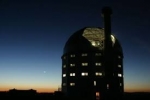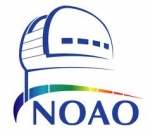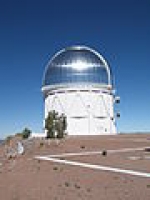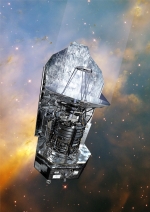Displaying items by tag: observatory
U.S. Naval Observatory (USNO)
The United States Naval Observatory (USNO) is one of the oldest scientific agencies in the United States, with a primary mission to produce Positioning, Navigation and Timing (PNT) for the U.S. Navy and the U.S. Department of Defense.
Located in Northwest Washington, D.C. at the Northwestern end of Embassy Row, it is one of the pre-1900 astronomical observatories located in an urban area; at the time of its construction, it was far from the light pollution thrown off by the (then-smaller) city center. The USNO operates the "Master Clock", which provides precise time to the GPS satellite constellation run by the U.S. Air Force. The USNO performs radio VLBI-based positions of quasars with numerous global collaborators, in order to produce Earth Orientation parameters.
The U.S. Naval Observatory (USNO) provides a wide range of astronomical data and products, and serves as the official source of time for the U.S. Department of Defense and a standard of time for the entire United States.
South African Observatory (SAAO)
The South African Astronomical Observatory (SAAO) is the national centre for optical and infrared astronomy in South Africa.
Its prime function is to conduct fundamental research in astronomy and astrophysics. It does so by providing a world-class facility to scientists.
The SAAO promotes astronomy and astrophysics in Southern Africa, by sharing research findings and discoveries. So, to learn more about the wonders of space, start exploring our website now.
National Optical Astronomy Observatory (NOAO)
The National Optical Astronomy Observatory (NOAO) is the United States national observatory for ground based night time ultraviolet-optical-infrared (OUVIR) astronomy. The National Science Foundation (NSF) funds NOAO to provide forefront astronomical research facilities for US astronomers. However, professional astronomers from any country in the world may apply to use the telescopes operated by NOAO under the NSF's "open skies" policy. Astronomers submit proposals for peer review to gain access to the telescopes which are scheduled every night of the year for observations (with the exception of Christmas and New Year's Eve).
The NOAO headquarters are located in Tucson, Arizona and are co-located with the headquarters of the National Solar Observatory. The NOAO is operated by the Association of Universities for Research in Astronomy (AURA), under a cooperative agreement with the NSF.
Cerro Tololo Inter-American Observatory (CTIO)
The Cerro Tololo Inter-American Observatory (CTIO) is an astronomical observatory located on Cerro Tololo in the Atacama Desert of northern Chile, with additional facilities located on Cerro Pachón about 10 kilometres to the southeast. It is within the Coquimbo Region and approximately 80 kilometres east of La Serena, where support facilities are located.
The site was identified by a team of scientists from Chile and the United States in 1959, and it was selected in 1962. Construction began in 1963 and regular astronomical observations commenced in 1965. Construction of large buildings on Cerro Tololo ended with the completion of the Víctor M. Blanco Telescope in 1974, but smaller facilities have been built since then. Cerro Pachón is still under development, with two large telescopes inaugurated since 2000, and one in the early stages of construction.
The principal telescopes at CTIO are the 4 m Víctor M. Blanco Telescope, named after Puerto Rican astronomer Victor Manuel Blanco, and the 4.1 m Southern Astrophysical Research (SOAR) telescope, which is situated on Cerro Pachón. Other telescopes on Cerro Tololo include the 1.5 m, 1.3 m, 1.0 m, and 0.9 m telescopes operated by the SMARTS consortium. CTIO also hosts other research projects, such as PROMPT, WHAM, and LCOGTN, providing a platform for access to the southern hemisphere for U.S. and world-wide scientific research.
Las Cumbres Observatory Global Telescope Network - LCOGT
Las Cumbres Observatory Global Telescope Network (LCOGT) is a non-profit private operating foundation. The network's goal is to build a global network of up to 40 longitudinally spaced robotic telescopes for scientific and educational use. The longitudinal spacing would provide complete latitude coverage in both hemispheres to allow continuous observations of any astronomical object.
The network currently consists of (as of February 2012) two fully operational 2-meter telescopes, Faulkes Telescope North and Faulkes Telescope South.
National Astronomical Observatory of Japan (NAOJ)
The National Astronomical Observatory of Japan (国立天文台 kokuritsu tenmondai) (NAOJ) is an astronomical research organisation comprising several facilities in Japan, as well as an observatory in Hawaii. It was established in 1988 as an amalgamation of three existing research organizations - the Tokyo Astronomical Observatory of the University of Tokyo, International Latitude Observatory of Mizusawa, and a part of Research Institute of Atmospherics of Nagoya University.
In 2004, after the Japan reform of national research organizations, NAOJ became a division of the National Institutes of Natural Sciences.
SOFIA observatory
The Stratospheric Observatory for Infrared Astronomy (SOFIA) is a joint project of NASA and the German Aerospace Center ( DLR) to construct and maintain an airborne observatory. NASA awarded the contract for the development of the aircraft, operation of the observatory and management of the American part of the project to the Universities Space Research Association (USRA) in 1996.
The DSI (Deutsches SOFIA Institut) manages the German parts of the project which are primarily science and telescope related. SOFIA's telescope saw first light on May 26, 2010. SOFIA is the successor to the Kuiper Airborne Observatory.
Gemini Observatory
The Gemini Observatory is an astronomical observatory consisting of two 8.19-metre (26.9 ft) telescopes at sites in Hawai and Chile. Together, the twin Gemini telescopes provide almost complete coverage of both the northern and southern skies. They are currently among the largest and most advanced optical/infrared telescopes available to astronomers.
The Gemini telescopes were built and are operated by a consortium consisting of the United States, United Kingdom, Canada, Chile, Brazil, Argentina, and Australia. This partnership is managed by the Association of Universities for Research in Astronomy (AURA).
Herschel Space Observatory
A space telescope observing in the far-infrared.
The Herschel Space Observatory is a European Space Agency space observatory sensitive to the far infrared and submillimetre wavebands. It is the largest infrared space telescope ever launched, carrying a single mirror of 3.5 metres (11.5 ft) in diameter.
The observatory was carried into orbit in May 2009, reaching the second Lagrangian point (L2) of the Earth-Sun system, 1,500,000 kilometres (930,000 mi) from the Earth, about two months later. Herschel is named after Sir William Herschel, the discoverer of the infrared spectrum and planet Uranus.
The Herschel Observatory is capable of seeing the coldest and dustiest objects in space; for example, cool cocoons where stars form and dusty galaxies just starting to bulk up with new stars. The observatory will sift through star-forming clouds—the "slow cookers" of star ingredients—to trace the path by which potentially life-forming molecules, such as water, form. The United States through NASA is participating in the ESA-built and -operated observatory. It is the fourth 'cornerstone' mission in the ESA science program, along with Rosetta, Planck, and the Gaia mission.
XMM-Newton
The XMM-Newton (X-ray Multi-Mirror Mission - Newton) is an orbiting X-ray observatory launched by ESA in December 1999 on a Ariane 5 rocket. It is named in honor of Sir Isaac Newton.
Its mission is turned towards deep space and aimes to increasing our knowledge of very hot objects created when the Universe was very young,
Originally known as the High Throughput X-ray Spectroscopy Mission it was placed in a very eccentric 48 hour elliptical orbit at 40°; at its apogee it is nearly 114,000 kilometres (71,000 mi) from Earth, while theperigee is only 7,000 kilometres (4,300 mi)
The satellite weighs 3,800 kilograms (8,400 lb), is 10 metres (33 ft) long and 16 metres (52 ft) in span with its solar arrays deployed. It holds three X-ray telescopes, developed by Media Lario of Italy, each of which contains 58 Wolter-type concentric mirrors. The combined collecting area is 4,300 cm². The three European Photon Imaging Cameras (EPIC) are sensitive over the energy range 0.2 keV to 12 keV. Other instruments onboard are two reflection grating spectrometers which are sensitive below ~2 keV, and a 30 centimetres (12 in) diameter Ritchey-Chretien optical/UV telescope.
The mission was proposed in 1984 and approved in 1985; a project team was formed in 1993 and development work began in 1996. The satellite was constructed and tested from March 1997 to September 1999. Launched in Dec 1999, in-orbit commissioning started Jan 2000. First images published Feb 2000. The original mission lifetime was two years, it has now been extended for further observations until at least 2010, and again until 2012, and technically could operate until 2018.
Observations are managed and archived at the European Space Astronomy Centre (formerly known as VILSPA) at Villafranca, Spain. The data are processed at the XMM-Newton Survey Science Centre at the University of Leicester, England.
The European satellite XMM-Newton (X-ray Multi Mirror), built under contract to ESA by a consortium of 35 European companies with Astrium as prime contractor, by far excels its predecessor, the Astrium-built ROSAT satellite.










